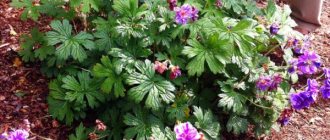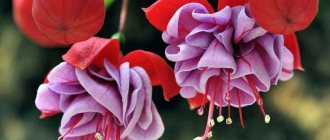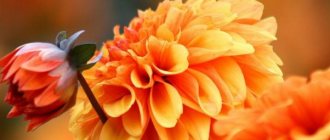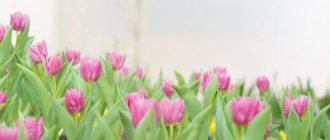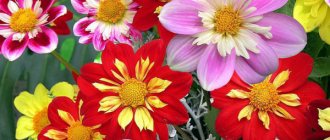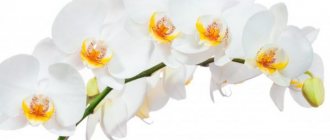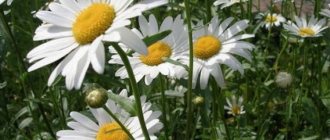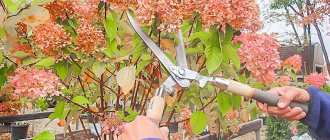Dahlias are widely used to decorate gardens and vegetable gardens. Gardeners are attracted by the ease of cultivation, perenniality, relative cheapness, variety and beauty of flowers.
This flower is quite unpretentious; it can be planted under trees, in partial shade. The plant comes from Mexico, so it loves warm and humid climates. It is advisable to protect it from gusts of north wind and plant it on the south side of the site. Dahlia loves space and fresh air - the area around it should be cleared of weeds. You should not plant the plant in lowlands and with close groundwater (60 cm). This will cause the root system to rot.
Dahlias
Dahlia flowering dates
Early varieties of dahlias begin to bloom 30-40 days after planting, later varieties - after 70-80 days. Most species of this plant bloom in June. The flowering period lasts until the first frost and ends in September-October. Subject to the storage conditions of dahlia tubers in winter and good weather conditions in spring, earlier flowering can be achieved, starting at the end of May.
When to plant dahlias in spring
Dahlias do not tolerate frosty weather well; during short frosts, the tubers can rot and die. Therefore, the timing of planting plants in open ground depends on weather conditions.
When to plant in spring according to the lunar calendar 2018
According to the lunar calendar of gardeners and gardeners, it is advisable to plant flower plants during the period of the waxing Moon. This is due to the fact that during the growth phase the satellite attracts all the water on the planet, including the sap in plant cells. In spring 2022, dahlias can be planted on the following dates: May 4-6, 14, 16-24, 26-28. Astrologers recommend planting later varieties on June 6-7, 10-11, 15-20, 22-25.
If the weather deteriorates on favorable days according to the lunar calendar, it is necessary to reschedule the procedure to another time, while avoiding the days of the full moon and new moon and the dates closest to them.
When to plant
Traditionally, the root crops of this flower are planted in the soil in the middle or end of May, when the ground has warmed up sufficiently. In addition, during this period there are most often no sudden changes in weather, cold rains and gusty winds. The day for planting must be chosen as warm and sunny.
In regions with a more favorable climate, dahlias can be planted in open ground in March-April. At the same time, it is necessary to carefully monitor weather forecasts and, if there is a threat of frost, provide the plants with careful shelter. At the same time, tubers pre-sprouted at home should be replanted.
What to do to make dahlias bloom as early as possible
In order for the flowering period of the bushes to come as quickly as possible, a month before planting in open ground, it is necessary to germinate the tubers, thereby preparing the plant for favorable and productive cultivation. To do this, in April you should sprinkle the root vegetables with a moistened coconut substrate, peat or sawdust and sand, and then place them in a warm place: a greenhouse, greenhouse or on a windowsill. The emerging sprouts can be planted in separate containers, while providing them with timely watering and additional care.
After 3-4 weeks, the tubers with young sprouts need to be moved to a permanent place. When planting dahlias in open ground, add special fertilizers. As the leaves appear, pinch the shoots. It is necessary to pinch the top of the stem above the third or fourth leaf. Carry out this procedure with pruning shears and disinfect the instrument after each removal. If you follow these recommendations, dahlias will bloom much earlier than expected.
How to get large flowers
To get large flowers and powerful stems, it is necessary to correctly form the bush and promptly remove the side shoots that appear in the axils of the leaves. This is due to the fact that the extra shoots take a lot of nutrients and prevent the flowers from developing. Therefore, pinching plants of medium and tall varieties is a mandatory procedure to obtain large buds.
Professional flower growers advise leaving 2-3 shoots on the tuber and cutting off excess stems throughout the season. In addition, it is necessary to remove the leaves at the bottom of the bush and cut off wilted flowers. This will provide light, heat and air access to the soil and will stimulate rapid plant growth.
Decorative dahlias are highly susceptible to various diseases and attacks by harmful insects. In order for young buds to remain strong, and subsequently large voluminous flowers to appear, it is necessary to regularly treat the bushes with special anti-pest agents, for example, solutions of celandine or wormwood, soap solution or systemic insecticides.
In addition, dahlias need proper moderate watering, timely fertilization with phosphorus and potassium, loosening the soil, cutting off dried leaves and removing faded inflorescences. Such comprehensive measures will allow flowers to develop and reach large sizes.
How to prolong the flowering of dahlias
Types of dahlias that bloom for quite a long time do not require additional care and can delight with their flowers for a long time. To increase the flowering period of annual plant varieties, you should regularly inspect the bushes and pick off drooping and dried heads. This method of care will prevent the plant from becoming depleted and will stimulate the formation of new buds.
In order for the flowering to be abundant and long-lasting, it is necessary to properly fertilize dahlias. It is better to carry out the last fertilizing no later than the end of July. In this case, the bushes will not actively grow greenery, and the flowers will receive more nutrients and will remain lush and beautiful longer.
At the end of August or beginning of September, hilling should be carried out, forming a small mound of earth around each plant. In this way, you can protect the tubers from strong differences in day and night temperatures and the first autumn frosts.
In addition, if weather conditions worsen and there is a threat of short-term sub-zero air temperatures, you should carefully cover the bushes with lightweight materials: polyethylene, geotextile or burlap. When warm weather sets in, the protective covering must be removed and the dahlia stems carefully straightened.
Dahlias - from planting to flowering
May 3, 2022 / Gennady Litavrin, member of the Moscow Flower Growers Club on Novinsky
Dahlias began to be grown in Russian gardens in the mid-19th century. They immediately gained recognition among flower growers. And this is not surprising. After all, such flowers, varied in shape, color and size, cannot leave anyone indifferent. It should be noted that they bloom for a very long time - from July until frost. I fell in love with dahlias as a child, when we were visiting my mother’s friend. They shocked me to such an extent that I asked my mother to visit her friend again and again. Just to admire these wonderful flowers.
Years passed, and the parents purchased a garden plot. I was already a student, but I remembered those flowers well from my childhood. The first dahlia planted was the “Phantom” variety, and then it started… The collection reached more than 150 varieties, and this at a time when it was very difficult to acquire the desired variety. I met the breeders of these flowers, such as Sukhanov V.M., Sidorova A.N., Nessonova I.N., Sharonova M.F., fortunately, they lived in the Moscow region. But I couldn’t resist a trip to Riga to the famous breeder, creator of popular dahlia varieties, K.K. Ruks. After all, it’s especially nice to receive new items first-hand. As a rule, plants grown from cuttings were purchased. What a joy it is when you come home with a box of treasured varieties, then you look forward to the flowering of new varieties, most of which simply shocked you with their perfection and beauty.
Notes
- For the convention of indicating the class of dicotyledons as a superior taxon for the group of plants described in this article, see.
- ↑ See.
- ↑
- ↑, p. 346-349.
- ↑ Shipunov A. B.
Family Heather // Biology: School Encyclopedia / Belyakova G. et al. - M.: BRE, 2004. - 990 p. — ISBN 5-85270-213-7. - - P. 151.
- Vermeulen, Nico.
Useful herbs. Illustrated Encyclopedia: Trans. from English B. N. Golovkina. - M.: Labyrinth Press, 2002. - 320 p. — ISBN 5-9287-0244-2. — P. 133. - ↑ Encyclopedic Dictionary of Medicinal, Essential Oil and Poisonous Plants / Comp. G. S. Ogolevets. - M.: Selkhozgiz, 1951. - P. 59. - 584 p.
- ↑ Takhtadzhyan A. L.
System of magnoliophytes. - L.: Nauka, 1987. - 439 p. — P. 101-103. - ↑
- ↑ Flora of the Russian Far East: Additions and changes to the publication “Vascular plants of the Soviet Far East”. T. 1-8 (1985-1996) / Rep. ed. A. E. Kozhevnikov and N. S. Probatova. - Vladivostok: Dalnauka, 2006. - P. 130. - ISBN 5-8044-0534-9.
- Vermeulen, N.
Useful herbs. Illustrated Encyclopedia: Trans. from English B. N. Golovkina. - M.: Labyrinth Press, 2002. - 320 p. — ISBN 5-9287-0244-2.
| Dracophyllum secundum | Bejaria imthurnii | Cassiope mertensiana |
When to plant dahlias?
The timing of planting plants in unprotected soil is directly dependent on the climatic conditions of a particular region. Usually, ready-made dahlia seedlings grown from tubers, seeds or cuttings are planted. Read more about this in the article “Working methods of propagating dahlias: from seeds, tubers, cuttings.”
When to plant dahlias in spring/summer:
- in the south of Russia - in April;
- in the middle zone - in the second half of May ;
- in the northern regions - in early or mid-June .
If the dahlias were planted too early and the young shoots turned black due to frost damage, do not rush to uproot and throw away the plants. The underground part could have survived. The buds of the root collar do not start growing all at once. There is a chance that new shoots will appear in place of dead sprouts.
Botanical description
The Latin name of the flower - Dahlia - was received by the dahlia at the end of the eighteenth century in honor of the Swedish botanist Anders Dahl. Literally twelve years later, the flower received a Russian name, but in honor of the St. Petersburg natural scientist Johann (Ivan) Georgi, who, although he was German by birth, lived and died in Russia his entire adult life, and is therefore considered a Russian scientist.
The flower comes from South America, but has long been cultivated and bred as an ornamental in many countries around the world. And in our gardens he is truly an old-timer. True, it is too tender and does not tolerate frost, so it requires special care - in winter its tubers are dug up and stored in more comfortable conditions, and in the spring they are replanted.
This herbaceous plant of the Asteraceae family has fairly large asteraceous flowers of various shapes and colors. The root system is a group of tubers and thinner roots. Their ripening begins in early spring, immediately after planting, but the root tubers will finally ripen only towards the end of the growing season.
The stems are hollow, in some varieties they can reach a height of up to two and a half meters. The leaves are paired, pinnate in shape, and can be from ten to forty centimeters in length. They can be smooth or have varying degrees of pubescence. Color: Various shades of green and purple.
The flowers are complex, collected in inflorescences-baskets. The edges of the flowers have a tongue shape and a variety of colors - from monochromatic to multi-colored. The middle flowers are tubular, usually yellow or red.
The flower was discovered by the Spaniards in the first quarter of the sixteenth century during their first landings on the coast of South America. The Indians consumed the plant as food, and the hollow stem was used as a breathing tube for swimming underwater. By the way, in their language dahlias were called “chichipatl” - “flower with a hollow stem.”
Once in Europe, dahlias quickly gained popularity among connoisseurs of rare plants. Breeders began experimenting with enthusiasm and by the beginning of the nineteenth century they had developed many decorative varieties of spherical double dahlias.
Over time, they quickly spread throughout the world and won popular love. In our country, already in 1842 it was possible to buy a collection of two hundred copies. And at the beginning of the formation of Soviet power in 1920, many varieties were purchased from the USA and planted in the country’s botanical gardens and greenhouses.
For two hundred years, breeders worked tirelessly to develop new varieties. Now there are more than tens of thousands of them. To understand all this diversity, it was necessary to classify dahlias at least by the shape of the flowers.
For beginners, it will be useful to know that there are perennial dahlias and annual dahlias. The latter are grown exclusively by seed. But those that reproduce by tubers are of the greatest interest, because with proper care they can decorate the garden plot for many years.
Choosing a place to grow dahlias
Dahlias (the scientific name for dahlias) are not very fussy, however, they like warmth, need protection from gusts of wind and do not bloom in the shade. Choose a sunny area, closed on the north side by a wall, fence or dense hedge. Penumbra is acceptable - the space under the sparse crown of trees. It is important that there is enough space and fresh air around.
IN THE PHOTO: When choosing a place for dahlias, it is better if there is a fence or wall located on the north side of it.
Dahlias should not be planted in lowlands. Cold air accumulates there, which can kill plants!
Growing dahlias is possible on fertile, permeable soils with good structure. Groundwater should not reach the surface closer than 60–70 cm . The slightest stagnation leads to rotting of the root tubers. It will not be possible to grow planting material for next year in such conditions.
Low soil permeability can be improved by adding:
- coarse river sand;
- fine gravel;
- coal slag (not suitable if the soil on the site has a neutral or alkaline pH reaction).
The soil structure is improved by adding organic matter!
When planting dahlias, check the acid-base (pH) reaction of the soil. It should be neutral, or at least slightly acidic. Acidic soil is neutralized with slaked lime at the rate of: 100 grams for non-medium acid soils and 150 grams for very acidic soils per 1 sq. m. meter _ An indicator of highly acidic soil will be water standing for a long time in the spring on the site, mosses and horsetails in the vegetation cover. Strongly alkaline soils are alkalized by adding peat. However, this procedure will have to be carried out annually, and even in this case, the dahlias will not grow well.
When tubers form, plants consume a large amount of nutrients from the soil, depleting it. Planting dahlias in the same place for the second year is not recommended.
Dahlias are close relatives of asters. They consume the same substances from the soil and suffer from the same diseases. Therefore, it is not recommended to plant them after each other.
The plot of land selected for dahlias is prepared in advance. During autumn digging, three to five kilograms per square meter of humus or compost are added. In the spring, mature compost is mixed with wood ash, scattered throughout the area and the top layer of soil is loosened shallowly using a rake.
Soil preparation
For good flowering, dahlias need fertile neutral or slightly acidic soil with pH 6-7. Also, the ground must be permeable. Therefore, loams are best suited for dahlias.
At the bottom of the hole in which dahlias are planted, first pour 5 cm of a drainage layer (expanded clay, sand or gravel), then compost or humus, the same amount of sand and mix with soil. You can also add sawdust and wood ash there.
Dahlias: growing and care
Caring for dahlias is simple, but requires systematicity. It is important to follow the planting pattern, regularly water and feed the plants. And to achieve the best results, it is recommended to correctly form the bush.
How to plant dahlias?
To get beautiful large dahlia flowers, planting must be carried out in accordance with the following scheme:
- 80 x 60 cm - for tall varieties;
- 60 x 45 cm - for medium-sized children;
- 40 x 30 cm - for dwarf dahlias;
- 100 x 100 cm - for cutting.
Before planting dahlia tubers, the selected area is leveled and planting holes are dug. For tall varieties, strong stakes from four centimeters in diameter and up to two meters in height are driven in. This is necessary to protect brittle shoots from damage in strong winds, as well as from drooping towards the ground due to the heaviness of the inflorescences. Medium-sized and dwarf varieties do not need support.
IN THE PHOTO: Before planting seedlings of tall varieties of dahlias, it is necessary to dig supporting pegs near the holes.
To prevent dahlias from being damaged when transplanted from containers to beds, they are watered generously within 4 hours. The earthen lump will become wet, and it will become much easier to pull the root system out of the pot. The soil mixture is not removed from the roots; the plant is placed in a planting hole, buried 4–5 cm below ground level. The remaining hole is covered to the top with garden soil.
Video: how to plant dahlias; preparing the pit, planting a tuber and grown dahlia
LePlants.ru editorial advice: when you start planting dahlias, don’t forget to make watering ditches around each bush and fill them with water! This will ensure the soil is evenly compacted around the roots.
Caring for dahlias
Dahlias have a powerful ground part, but the root system that feeds it is relatively small. For full development, planting and caring for dahlias is carried out with regular feeding and watering.
When adding water, the soil is poured so that it gets wet to a depth of 25–30 cm. Deeper penetration of moisture can cause stagnation and provoke rotting. You can read even more about the problems that arise when growing dahlias and how to combat them in our article “Diseases and pests of dahlias: identify, fight, and take preventive measures.”
IN THE PHOTO: Dahlias should be watered abundantly, especially in dry weather. However, under no circumstances should you look at flowers, as the lovely woman in the photo does.
Fertilize a flower bed three times during the summer : during the intensive growth of green mass, when planting flower buds and during the flowering period. Feed with liquid fertilizer, pouring two to five liters (depending on size) under each bush.
A few more classes
Which dahlia flower to choose for planting in your garden depends on your taste preferences. But many owners of private houses agree that one of the most spectacular varieties of this plant are representatives of the spherical class. They differ in the corresponding shape of the inflorescences. They may be a little flattened. But there are also dahlias that have an almost perfect ball shape. They have rather heavy inflorescences. Their size varies from 7 to 20 cm. The size of the bush can also vary significantly, depending on the variety. Their inflorescences are predominantly red, but can range from soft pink to purple.
Another popular variety is the pompon dahlia. They are similar to the previous class, but their shape is more flattened. There are also some differences in the shape of the petals. Their color is usually gradient, often consisting of three different shades. Usually their inflorescences are small in size (on average 8 cm). But the stems can be high up to 120 cm.
Cactus dahlias look original. These are buds with thick terry petals. Their shape is quite unusual, reminiscent of the needles of a cactus or a hedgehog curled into a ball. In this class there are varieties whose buds have up to 6 different shades. These are very beautiful dahlias. These are the largest buds, reaching a diameter of 35 cm. Their strong stems reach a height of 2 m. This is one of the most popular classes.
The semi-cactus class is worth considering as one of the best options when choosing flowers in the garden. Dahlias of this subspecies have some petals (usually the outer ones) cactus-shaped, and the rest similar to another variety. These inflorescences are inferior in size to the previous group. But they are still quite large. The inflorescences have a diameter of 8 to 30 cm, depending on the variety. Moreover, plants of this class are usually tall. Some of them are capable of reaching a height of 2 m. But there are also dwarf varieties (up to 30 cm).
The nymphaeum class includes very graceful flowers. They have terry petals, which are large in area. The buds look a bit like a lotus. They reach a diameter of 7-18 cm. The stems can grow in height up to 70-140 cm. The colors can be varied. But almost always there is white in it. Many varieties have radial symmetry.
Decorative dahlias have a certain, specially bred feature. This may be the shape of the petals or the shade of modified stamens, etc. Most often these are hybrids that are characterized by high survival rates. These are very beautiful plants. They have medium or large buds measuring 12-25 cm and stems 100-150 cm high. Their leaves and stems are darker than those of other subspecies.
Dahlia flowering
Dahlia received its proud name in honor of the Russian traveler, ethnographer and naturalist of German origin Johann Georgi. In foreign literature, the flower is known under the name “Dahlia”. South America is considered the birthplace of the dahlia. The ancient Aztecs saw it as the earthly embodiment of the sun and used it in solar cults. In modern Mexico, the flower has acquired the status of a national symbol. Since the end of the 18th century, the plant became widespread in the Old World and more than once caused a fashion boom, becoming the most popular and sought-after flower, especially among the nobility.
Dalia belongs to the Asteraceae family, has 42 species and an unimaginable many (about 15 thousand) varieties. Under natural conditions, wild dahlia can reach six meters in height. Garden cultivars of this plant are much lower - usually do not exceed one and a half meters.
Dahlia flowers can be either simple or double, sometimes spherical. In some garden species, “echoes” of wild American ancestors have been preserved, the baskets of which were composed of two forms of flowers: reed (external, not producing offspring) and tubular (internal, fruitful). The shades of dahlias are innumerable. Flowers are monochrome and variegated.
The great advantage of these plants is their rather long flowering. In the middle zone it begins approximately in mid-late June and ends with the onset of frost. Due to the long flowering period, which lasts almost until winter, dalia is nicknamed the “queen of autumn flower beds” - after all, at the time when dahlias bloom, most garden crops die off or go into winter “dormant” mode.
Features of the view
Dahlias are distinguished by their bright colors; they can be double or semi-double. The most common flowers are spherical, pom-pom, simple, collar-shaped or cactus-shaped.
Characteristics of annual dahlias:
- plant height 35–120 cm;
- flower diameter – up to 12 cm;
- up to 15 buds can form on each shoot;
- Flowering begins in June-July and continues until frost.
To understand which species are best to plant, novice gardeners try to understand the plant varieties. Information about the types of annual dahlias with names will help.
Funny boys
The most common variety is the Merry Guys variety. These are dwarf annual dahlias that are easy to grow. The color of flower petals is yellow, burgundy, cream, and green.
Pompom Mix
A popular large species is Pom Pom Mix. The plants reach a height of 120 cm; more than 10 flowers are simultaneously formed on the stems. They are most often grown for the purpose of further cutting.
The dwarf Figaro variety is grown along borders. It is distinguished by early flowering and rich color of flowers.
Minion
A popular border variety, up to 40 centimeters high, suitable for growing in flowerpots, flower pots, and balcony boxes. Simple flowers have a coverage of 5-9 cm, varied in color: from white and red to two-color.
Minion
Colarette Dandy
A mixture of medium-sized (50 centimeters) dahlias belongs to the “collar” varieties. The yellow center is framed by bright, contrasting semi-double ruffles. The spectacular mix won the hearts of domestic flower growers.
Colarette Dandy
Firework
Low, compact dahlias of this variety attract with their variety of colors; there are peculiar strokes along the petal. Salute grows to a height of only 20-25 centimeters, but the flower is quite large - 8 cm.
Firework
Bright pom-poms
Tall annual dahlia, stem length more than a meter. The petals are collected in beautiful, large and dense pompoms. An excellent cut variety, as the inflorescence is located on a long leafless stem.
Bright pom-poms
Piccolo
This version of annual dahlias is especially loved by gardeners. The bushes are medium in height (45 cm) and have a compact shape; they are convenient to grow in containers and pots. The color of a simple inflorescence can be yellow, white, red, or pink.
Piccolo
Cactus mixture
It is worth taking a closer look at such a chic variety (a mixture of colors) as cactus-shaped dahlias. Medium-sized (more than half a meter) plants have double inflorescences with pointed tips, and their size reaches 8-12 cm.
Cactus mixture
Bambino
Double flowers bloom in large numbers on a small dwarf bush. The height of the bambino grows only 25 centimeters; the coverage of the blossoming buds of this variety is pleasing - 6-8 centimeters.
Bambino
Sources
- https://ogorod-bez-hlopot.ru/georginy-odnoletnie-sorta-posadka.html
- https://flowergarden.pro/rassada-tsvetov-georginov-vyrashhivanie-v-domashnih-usloviyah/
- https://SelHozObzor.ru/sad/tsvety/kogda-sejat-georginy-odnoletnie-na-rassadu
- https://GardenGround.ru/odnoletnie/odnoletnie-georginy/
- https://heaclub.ru/odnoletnie-georginy-chto-eto-za-cvety-i-kak-oni-vyrashhivayutsya-kak-pravilno-poseyat-odnoletnie-georginy-na-rassadu-posev-pikirovka-vysadka-v- grunt-blagopriyatnye-dni-luchshie-sorta-odnoletni
- https://AgroGnom.ru/flowers/dahlia/georginy-odnoletnie-kogda-sazhat-vyrashhivanie-iz-semyan.html
- https://monamo.ru/rasteniya/georginy-odnoletnie-posadka-i-uhod
- https://dachnyuchastok.ru/vyrashchivaem-odnoletnie-georginy/
- https://MrDachnik.com/georgin
- https://VseProDachu.ru/sad-ogorod/cvety/georginy/georginy-odnoletnie-posadka-i-uxod/
What to do to make dahlias bloom as early as possible?
To enjoy the flowering of dalia at the beginning of summer, the tubers must be prepared in advance for planting. Around April, they are dug into moist, organic-poor soil (sand, coconut fiber, peat-based soil mixture) and placed for forcing in a greenhouse, hotbed, or simply on a window sill in a room. In May, rhizomes with green shoots that have appeared are planted in the open air in a permanent place. With this approach, dahlias begin to bloom a month after planting, while in the absence of preliminary forcing, the first flowers are observed no earlier than the end of July. To avoid an unwanted shift in the flowering of dahlias, they also try not to be late with pinching. They are produced after four pairs of leaves appear on the dalia. Dwarf, border varieties of dalia and plants grown as annuals do not need pinching.
Reproduction methods
You can grow dahlias in your yard or on your property by growing even one bush.
Cuttings
After digging up the rhizome, cut off the sprout along with part of the tuber and plant it in a pot. After a short time, the dahlia stalk sprouts roots. A little above the first pair of leaves, cut the stem and place it in the ground under a plastic bottle. When the cuttings have roots, they are transplanted into the ground.
Seeds
Before frost arrives, grains are collected from the flowers of single-row or other varieties of non-double dahlias, from which seedlings are grown in the spring. The box or container is filled with a substrate prepared from equal parts:
- peat;
- sand;
- compost.
In a room where the temperature is at least 20°C, dalia seeds sprout within 20 days. After a couple of leaves appear, the seedlings dive. In warm weather, seedlings are hardened in air. When the risk of frost returns decreases, the young bushes are sent to an alpine hill or flower garden.
Tubers
Summer residents do not have enough time to collect seeds and grow seedlings, so they breed dahlias, dividing the tubers so that at least one eye remains in each half. The sprout produces a new shoot.
How to get large flowers?
The fewer flower ovaries on a plant, the larger they are, since all the nutrients will be directed to a few flowers, rather than dispersed over many. This rule also applies to dahlias. It is recommended to leave two or three main stems on the dalia, on which buds will subsequently appear. All the rest are removed in their infancy. In addition, it was noticed that large flowers grow on bushes driven out of young trees. Therefore, you should carefully consider the planting material and discard old tubers in advance.
Planting material
Dahlia planting material may vary. These are seeds, seedlings, and dahlia tubers.
You should choose dahlia tubers carefully, this is very important. They should be dense, not flabby, light brown in color, always with a growing point or with barely noticeable sprouts. Dried or soft wrinkled tubers are difficult to restore, so, of course, you should not buy them. If the tubers are purchased too early, they must be properly stored so that they do not dry out. It is better to store them in the refrigerator or in a cool place in sawdust, sand or peat.
Why do dahlias bloom poorly?
There may be several reasons. Let's mention the main ones.
- Often gardeners, in pursuit of bush lushness, overfeed plants with fertilizers, primarily nitrogen. And, as you know, this element causes the crop to intensively increase its leaf mass. The ripening process of flower buds slows down. During the period of dalia budding, the nitrogen content in complex fertilizers should be minimized, and if there is an excess of the substance in the soil, it should be abandoned altogether.
- Dahlias are native to tropical and subtropical latitudes. In the wild, they are located on the sun-drenched hillsides of Mexico, Chile and Peru - regions where the number of sunny days per year sometimes reaches three hundred. It is quite natural that good lighting is one of the important conditions for the normal development of these plants. It is recommended to choose open garden areas for planting dalias. Lack of sunlight leads to shredding of flower stalks and a decrease in pigment in the petals; dahlias bloom later, and sometimes do not form buds at all.
- When cultivating a plant with tubers, many gardeners make the mistake of planting in one bush a bunch of connected rhizomes left after harvesting the dahlia the previous fall, believing that the more massive the root, the more magnificent the flowering will be. In fact, the best results are shown by plants grown from a separate single root tuber.
